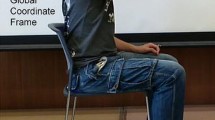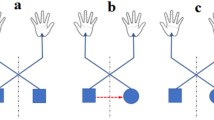Abstract
It has been observed that the motion of the arm end-point (the hand, fingertip or the tip of a pen) is characterized by a number of regularities (kinematic invariants). Trajectory is usually straight, and the velocity profile has a bell shape during point-to-point movements. During drawing movements, a two-thirds power law predicts the dependence of the end-point velocity on the trajectory curvature. Although various principles of movement organization have been discussed as possible origins of these kinematic invariants, the nature of these movement trajectory characteristics remains an open question. A kinematic model of cyclical arm movements derived in the present study analytically demonstrates that all three kinematic invariants can be predicted from a two-joint approximation of the kinematic structure of the arm and from sinusoidal joint motions. With this approach, explicit expressions for two kinematic invariants, the two-thirds power law during drawing movements and the velocity profile during point-to-point movements are obtained as functions of arm segment lengths and joint motion parameters. Additionally, less recognized kinematic invariants are also derived from the model. The obtained analytical expressions are further validated with experimental data. The high accuracy of the predictions confirms practical utility of the model, showing that the model is relevant to human performance over a wide range of movements. The results create a basis for the consolidation of various existing interpretations of kinematic invariants. In particular, optimal control is discussed as a plausible source of invariant characteristics of joint motions and movement trajectories.
Similar content being viewed by others
References
Adam JJ, van der Bruggen DPW, Bekkering H (1993) The control of discrete and reciprocal target-aiming responses: evidence for the exploitation of mechanics. Hum Mov Sci 12:353–364
Alberts JL, Saling M, Adler CH, Stelmach GE (2000) Disruptions in the reach-to-grasp actions of Parkinson’s patients. Exp Brain Res 134:353–62
Atkeson CG, Hollerbach JM (1985) Kinematic features of unrestrained vertical arm movements. J Neurosci 5:2318–2329
Bastian AJ, Martin TA, Keating JG, Thach WT (1996) Cerebellar ataxia: abnormal control of interaction torques across multiple joints. J Neurophysiol 76:492–509
Bernstein N (1984) Biodynamics of locomotion. In: Writing HTA (ed) Human motor actions: Bernstein reassessed. North-Holland, Amsterdam, pp 171–222
Berthier NE, Clifton RK, McCall DD, Robin DJ (1999) Proximodistal structure of early reaching in human infants. Exp Brain Res 127:259–269
Buchanan JJ, Park JH, Ryu YU, Shea CH (2003) Discrete and cyclical units of action in a mixed target pair aiming task. Exp Brain Res 150:473–489
Buchanan JJ, Park JH, Shea CH (2004) Systematic scaling of target width: dynamics, planning, and feedback. Neurosci Lett 367:317–322
Buchanan JJ, Kelso SA, de Guzman GC (1997) Self-organization of trajectory formation. I. Experimental evidence. Biol Cybern 76:257–273
Castiello U, Bennett KMB, Bonfiglioli C, Peppard RF (2000) The reach-to-grasp movement in Parkinson’s disease before and after dopaminergic medication. Neuropsychologia 38:54–59
Chaffin DB, Andersson GBJ (1984) Occupational biomechanics. Wiley, New York
De’Sperati C, Viviani P (1997) The relationship between curvature and velocity in two-dimensional smooth pursuit eye movements. J Neurosci 17:3932–3945
Diedrich FJ and Warren WH (1995) Why change gaits-dynamics of the walk run transition. J Exp Psychol Hum Percept Perform 21:183–202
Dounskaia N, Ketcham CJ, Stelmach GE (2002a) Commonalities and differences in control of a large set of drawing movements. Exp Brain Res 146:11–25
Dounskaia N, Ketcham CJ, Stelmach GE (2002b) Influence of biomechanical constraints on horizontal arm movements. Motor Control 6:366–387
Dounskaia N, Wisleder D, Johnson TA (2005) Influence of biomechanical factors on substructure of pointing movements. Exp Brain Res 164:505–516
Flash T, Hogan N (1985) The coordination of arm movements: an experimentally confirmed mathematical model. J Neurosci 7:1688–1703
Flash T, Inzelberg R, Schectman E, Korcyzn AD (1992) Kinematic analysis of upper limb trajectories in Parkinson’s disease. Exp Neurol 118:215–26
Fitts PM (1954). The information capacity of the human motor system in controlling the amplitude of movement. J Exp Psychol 47:381–391
Georgopoulos AP, Kalaska JF, Massey JT (1981) Spacial trajectories and reaction times of aimed movements: effects of practice, uncertainty, and change in target location. J Neurophysiol 46:725–743
Graham KM, Moore KD, Cabel DW, Gribble PL, Cisek P, Scott SH (2003) Kinematics and kinetics of multijoint reaching in nonhuman primates. J Neurophysiol 89:2667–2677
Gribble PL, Ostry DJ (1996) Origins of the power law relation between movement velocity and curvature: modeling the effects of muscle mechanics and limb dynamics. J Neurophysiol 76:2853–2860
Guiard Y (1993) On Fitts’s and Hooke’s laws: simple harmonic movement in upper limb cyclical aiming. Acta Psychologica 82:139–159
Guiard Y (1997) Fitts’ law in the discrete vs. cyclical paradigm. Hum Mov Sci 16:97–131
Haggard P, Richardson J (1996) Spatial patterns in the control of human movement. J Exp Psychol Hum Percept Perform 22: 42–62
Harris CM, Wolpert DM (1998) Signal-dependent noise determines motor planning. Nature 34:780–784
Hogan N (1984) An organizing principle for a class of voluntary movements. J Neurosci 4:2745–2754
Hogan N (1985) The mechanics of multi-joint posture and movement control. Biol Cybern 52:315–331
Jordan MI, Flash T, Arnon Y (1994) A model of the learning of arm trajectories from spatial deviations. J Cognit Neurosci 6:359–376
Konczak J, Dichgans J (1997) The development toward stereotypic arm kinematics during reaching in the first 3 years of life. Exp Brain Res 117:346–354
Konczak J, Borutta M, Topka H, Dichgans J (1997) The development of goal-directed reaching in infants. Exp Brain Res 113:465–474
Lacquaniti F, Terzuolo CA, Viviani P (1983) The law relating kinematic and figural aspects of drawing movements. Acta Psychologica 54:115–130
Lebedev S, Tsui WH, Van Gelder P (2001) Drawing movements as an outcome of the principle of least action. J Math Psychol 45:43–52
Levin MF (1996) Interjoint coordination during pointing movements is disrupted in spastic hemiparesis. Brain 119:281–293
Marzke MW, Marzke RF (2000) Evolution of the human hand: approaches to acquiring, analysing and interpreting the anatomical evidence. J Anat 197:121–40 (Review)
Massaquoi S, Hallet M (1996) Kinematics of initiating a two-join arm movement in patients with cerebellar ataxia. Can J Neurol Sci 23:3–14
Massey J, Lurito J, Pellizzer G, Georgopoulos A (1992) Three-dimensional drawings in isometric conditions: relation between geometry and kinematics. Exp Brain Res 88:685–690
Miall RC, Haggard PN (1995) The curvature of human arm movements in the absence of visual experience. Exp Brain Res 103:421–428
Morasso P (1981) Spacial control of arm movements. Exp Brain Res 42:223–227
Nelson W (1983) Physical principles for economies of skilled movements. Biol Cybern 46:135–147
Pollick FE, Ishimura G (1996) The three-dimensional curvature of straight ahead movements. J Mot Behav 28:271–279
Richardson MJE, Flash T (2002) Comparing smooth arm movements with the two-thirds power law and the related segmented-control hypothesis. J Neurosci 22:8201–8211
Schaal S, Sternad D (2001) Origins and violations of the 2/3 power law in rhythmic three-dimensional arm movements. Exp Brain Res 136:60–72
Schwartz A (1994) Direct cortical representation of drawing. Science 265:540–542
Schwartz AB, Moran DW (1999) Motor cortical activity during drawing movements: population representation during leminiscate tracing. J Neurophysiol 82:2705–2718
Schwartz AB, Moran DW (2000) Arm trajectory and representation of movement processing in motor cortical activity. Eur J Neurosci 12:1851–1856
Soechting JF, Lacquaniti F (1981) Invariant characteristics of a pointing movement in man. J Neurosci 1:710–720
Soechting JF, Terzuolo CA (1987) Sensorimotor transformations underlying the organization of arm movements in three-dimensional space. Can J Physiol Pharmacol 66:502–507
Soechting JF, Lacquaniti F, Terzuolo CA (1986) Coordination of arm movements in three dimentional space. Sensorimotor mapping during drawing movement. Neurosci 17:295–311
Sternad D, Schaal S (1999) Segmentation of endpoint trajectories does not imply segmented control. Exp Brain Res 124: 118–136
Thelen E, Corbetta D, Kamm K, Spenser JP, Schneider K, Zernicke RF (1993) The transition to reaching: mapping intention and intrinsic dynamics. Child Dev 64:1058–1098
Todorov E, Jordan MI (1998) Smoothness maximization along a predefined path accurately predicts the speed profiles of complex arm movements. J Neurophysiol 80:696–714
Viviani P, Cenzato M (1985) Segmentation and coupling in complex movements. J Exp Psychol Hum Percept Perform 11: 828–845
Viviani P, Flash T (1995) Minimum-jerk, two-third power law and isochrony: converging approaches to movement planning. J Exp Psychol 21:32–53
Viviani P, Schneider R (1991) A developmental study of the relation between geometry and kinematics in drawing movements. Neurosci 10:211–218
Viviani P, Terzuolo CA (1982) Trajectory determines movement dynamics. Neurosci 7:431–437
Von Hofsten C (1991) Structuring of early reaching movements: a longitudinal study. J Mot Behav 23:280–292
Wolpert DM, Ghahramani Z, Jordan MI (1995) Are arm trajectories planned in kinematic or dynamic coordinates? An adaptation study. Exp Brain Res 103:460–470
Author information
Authors and Affiliations
Corresponding author
Rights and permissions
About this article
Cite this article
Dounskaia, N. Kinematic invariants during cyclical arm movements. Biol Cybern 96, 147–163 (2007). https://doi.org/10.1007/s00422-006-0109-1
Received:
Accepted:
Published:
Issue Date:
DOI: https://doi.org/10.1007/s00422-006-0109-1




